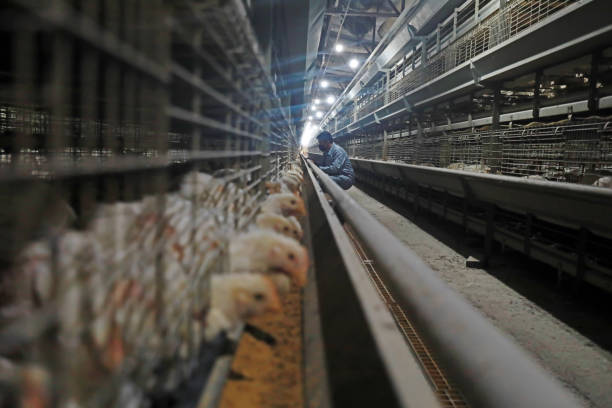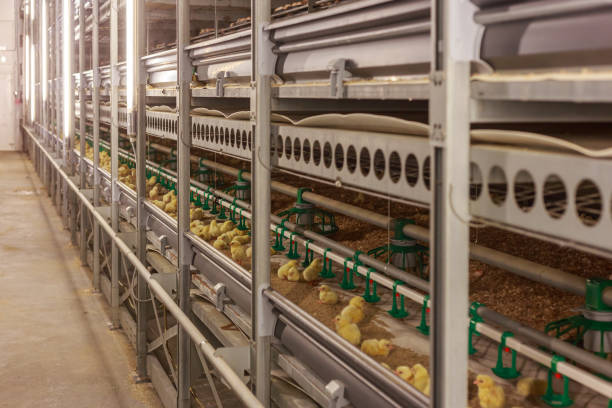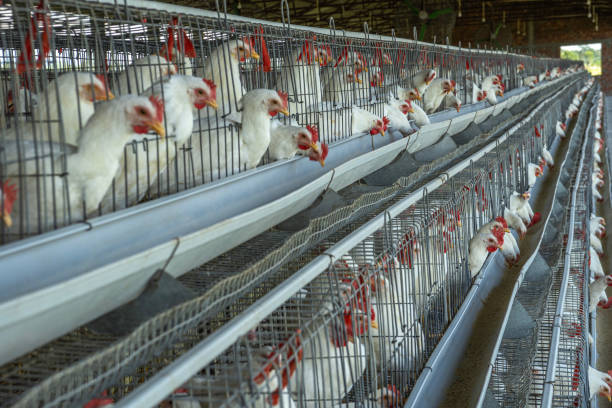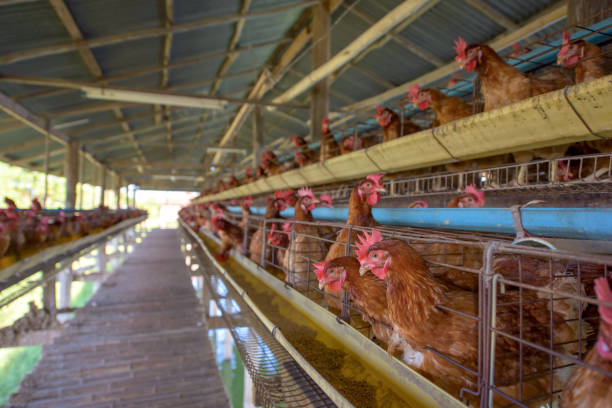
Broiler Cage Systems for 30,000 Birds: Optimizing Production in South Africa
Broiler Cage Systems for 30,000 Birds: Optimizing Production in South Africa
South Africa’s poultry industry is a significant contributor to the nation’s food security and economy. As demand for chicken meat continues to rise, farmers are constantly seeking ways to improve efficiency, productivity, and profitability. One proven solution for large-scale broiler farming is the adoption of broiler cage systems. This article explores how implementing a broiler cage system for 30,000 birds can optimize production in South Africa, covering key aspects like system design, management practices, and cost considerations.
The Growing Demand for Chicken in South Africa
Chicken is a staple protein source in South Africa, and its popularity continues to grow. This increasing demand creates both opportunities and challenges for poultry farmers. To meet the demand efficiently and sustainably, farmers need to adopt innovative technologies and management practices. Broiler cage systems offer a viable path towards achieving these goals, enabling higher stocking densities, improved feed conversion ratios, and better overall bird health.
Understanding Broiler Cage Systems
Broiler cage systems are designed to house broiler chickens in a structured and controlled environment. Unlike traditional floor systems, cage systems provide individual or small group housing compartments for the birds. This design offers several advantages, including:
Increased Stocking Density: Cage systems allow for higher stocking densities compared to floor systems, maximizing the use of available space.
Improved Feed Conversion Ratio (FCR): Reduced bird movement and competition for feed leads to better feed utilization and improved FCR.
Better Hygiene and Disease Control: Separating birds into individual cages minimizes the spread of diseases and facilitates easier cleaning and disinfection.
Reduced Mortality Rates: Enhanced monitoring and management practices help reduce mortality rates.
Easier Management and Monitoring: Cages facilitate easier access to birds for observation, vaccination, and health checks.
Designing a Broiler Cage System for 30,000 Birds
Setting up a broiler cage system for 30,000 birds requires careful planning and consideration. Here’s a breakdown of the critical design elements:
Cage Dimensions and Layout: The size and layout of the cages should be designed to provide adequate space for the birds to move and access feed and water. Common cage configurations include tiered and multi-tiered designs. Each cage must be sturdy, well-ventilated, and easy to clean.

Ventilation System: Proper ventilation is essential for maintaining air quality, removing excess moisture, and regulating temperature inside the poultry house. Ventilation systems can include natural ventilation, mechanical ventilation (fans), or a combination of both. In South Africa’s varying climate, a well-designed ventilation system is crucial for preventing heat stress and respiratory diseases.
Feeding System: Automatic feeding systems ensure that birds receive a consistent and adequate supply of feed. These systems can be chain feeders, trough feeders, or automatic weighing feeding systems. The design should minimize feed wastage and ensure that all birds have equal access to feed.
Watering System: A reliable watering system is vital for maintaining bird hydration and health. Nipple drinkers are commonly used in broiler cage systems as they provide clean and readily accessible water while minimizing spillage.
Manure Management System: Efficient manure removal is crucial for maintaining hygiene and preventing ammonia buildup. Manure removal systems can include belt systems, scraper systems, or flushing systems. The choice depends on factors like cost, ease of maintenance, and local regulations.
Lighting System: Proper lighting is essential for stimulating bird activity and growth. LED lighting systems are energy-efficient and provide consistent light distribution. Lighting programs can be customized to optimize bird performance and reduce stress.
Climate Control: South Africa experiences a range of climatic conditions, from hot and humid to cold and dry. Climate control systems, such as evaporative cooling pads, heaters, and insulation, are vital for maintaining optimal temperature and humidity levels inside the poultry house.
Key Considerations for Implementing the System in South Africa
Climate Adaptation: Selecting materials and designs that withstand South Africa’s diverse climate is critical. Insulation, efficient ventilation, and appropriate cooling or heating systems are non-negotiable.
Local Regulations: Farmers need to comply with local regulations regarding animal welfare, environmental protection, and waste management. Understanding and adhering to these regulations is essential for sustainable and responsible farming practices.
Infrastructure: Ensuring the availability of reliable electricity, water, and access roads is essential for operating a broiler cage system. Backup generators and water storage facilities may be necessary to mitigate disruptions.
Labor: Operating a broiler cage system requires skilled labor for feeding, watering, monitoring, and maintaining the equipment. Training local workers on modern poultry farming techniques is crucial for successful implementation.
Biosecurity: Implementing strict biosecurity measures is vital for preventing disease outbreaks. This includes controlling access to the farm, disinfecting equipment, and implementing vaccination programs.
Management Practices for Optimal Performance
Once the broiler cage system is installed, effective management practices are essential for maximizing its potential. These practices include:
Monitoring Bird Health: Regularly monitoring birds for signs of illness, injury, or stress is crucial for early detection and treatment. Maintain detailed records of bird health, growth rates, and mortality rates.
Feed Management: Providing a balanced and nutritious diet is essential for optimal growth and performance. Follow a feeding program that is tailored to the age and stage of development of the birds. Regularly monitor feed consumption and adjust the feeding program as needed.
Water Management: Ensuring a constant supply of clean and fresh water is vital for bird health and productivity. Regularly check and clean the watering system to prevent blockages and contamination.
Ventilation Management: Adjusting the ventilation system to maintain optimal air quality and temperature is crucial for preventing respiratory diseases and heat stress. Monitor ammonia levels and adjust ventilation rates as needed.
Manure Management: Removing manure regularly is essential for maintaining hygiene and reducing ammonia buildup. Follow a manure management plan that complies with local regulations and minimizes environmental impact.
Lighting Management: Implementing a lighting program that stimulates bird activity and growth is essential for optimal performance. Adjust the lighting program as needed based on the age and stage of development of the birds.
Pest Control: Implementing a pest control program is essential for preventing infestations of rodents, insects, and other pests. Regularly inspect the poultry house for signs of pest activity and take appropriate control measures.
Record Keeping: Maintaining detailed records of all aspects of the operation, including feed consumption, water consumption, mortality rates, and production data, is essential for monitoring performance and identifying areas for improvement.
Benefits of Broiler Cage Systems in the South African Context
For South African farmers aiming to scale up their operations and meet the growing demand for chicken meat, broiler cage systems offer numerous advantages:
Increased Production Capacity: Higher stocking densities within cage systems allow farmers to raise more birds in the same amount of space, significantly increasing overall production capacity.
Improved Efficiency: Automated feeding and watering systems, combined with better climate control, lead to improved feed conversion ratios and reduced labor costs, making operations more efficient.
Enhanced Bird Welfare: While cage systems are sometimes debated in terms of welfare, modern designs, when managed correctly, can provide a safe and controlled environment that minimizes stress and injury to the birds.
Reduced Disease Risk: Separation of birds into individual cages helps to limit the spread of diseases, and the elevated cages can reduce contact with manure, further decreasing the risk of infection.
Better Quality Control: The structured environment of cage systems allows for easier monitoring of individual bird health and performance, leading to better quality control over the final product.
Environmental Sustainability: With efficient manure management systems, cage systems can reduce the environmental impact of poultry farming by minimizing ammonia emissions and facilitating the production of valuable fertilizer.
Cost Analysis and ROI Projections
Setting up a broiler cage system for 30,000 birds involves significant upfront investment, but the long-term returns can be substantial. A thorough cost analysis should include:
Initial Investment: This includes the cost of cages, ventilation systems, feeding and watering systems, manure management systems, lighting systems, and climate control systems.
Operating Costs: This includes the cost of feed, water, electricity, labor, and veterinary services.
Revenue Projections: This includes the expected revenue from the sale of broiler chickens, taking into account factors like market prices, growth rates, and mortality rates.
A detailed ROI projection should take into account factors like feed conversion ratios, mortality rates, production cycles, and market prices. It’s crucial to conduct a feasibility study to determine the financial viability of the project and secure financing if necessary.
Choosing the Right Supplier
Selecting a reputable and reliable supplier is crucial for the success of a broiler cage system. Look for a supplier that:
Has experience in designing and installing broiler cage systems.

Offers high-quality equipment at competitive prices.
Provides excellent customer support and technical assistance.
Complies with local regulations and industry standards.
Offers training and support for farm workers.
A reliable supplier will help you design a broiler cage system that meets your specific needs and provides ongoing support to ensure its successful operation.

In conclusion, adopting broiler cage systems for 30,000 birds presents a significant opportunity for South African poultry farmers to optimize production, improve efficiency, and meet the growing demand for chicken meat. By carefully considering system design, management practices, and cost considerations, farmers can unlock the full potential of broiler cage systems and build a sustainable and profitable poultry farming operation. With meticulous planning, diligent implementation, and ongoing optimization, South African farmers can leverage broiler cage systems to elevate their poultry businesses to new heights. Embracing this technology positions them to compete effectively in the evolving agricultural landscape and contribute to the nation’s food security.
